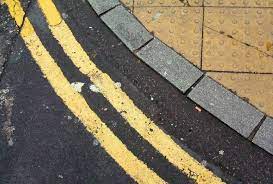Enhancing Road Safety: The Significance of Yellow Lines at the Edge of the Road

The Importance of Yellow Lines at the Edge of the Road
Yellow lines at the edge of the road play a crucial role in ensuring road safety and traffic flow. These markings are not just for decoration; they serve a specific purpose in guiding drivers and pedestrians and maintaining order on our roads.
Clear Boundary Markings
The yellow lines at the edge of the road serve as clear boundary markings that separate the road from other areas such as sidewalks, cycle lanes, or parking spaces. These lines help drivers stay within their lanes and prevent encroachment onto pedestrian or cycling paths.
Parking Regulations
In urban areas, yellow lines are often used to indicate no-parking zones or restrictions on where vehicles can park. By clearly marking these areas with yellow lines, authorities can regulate parking behaviour, improve traffic flow, and ensure emergency access routes remain clear.
Enhancing Visibility
Yellow is a highly visible colour that stands out against most road surfaces. By using yellow lines at the edge of the road, especially in low-light conditions or poor visibility situations, drivers can easily distinguish the boundaries of the road and make safer driving decisions.
Pedestrian Safety
Yellow lines also contribute to pedestrian safety by demarcating safe walking areas away from vehicular traffic. By clearly defining pedestrian pathways with yellow markings, pedestrians are less likely to stray into oncoming traffic, reducing the risk of accidents and improving overall road safety.
Maintenance and Compliance
Regular maintenance of yellow lines at the edge of the road is essential to ensure their visibility and effectiveness. Local authorities have a responsibility to repaint faded or worn-out markings promptly to maintain compliance with traffic regulations and uphold safety standards.
Conclusion
In conclusion, yellow lines at the edge of the road play a vital role in maintaining order, enhancing visibility, regulating parking behaviour, and improving overall road safety. These simple yet effective markings help create a safer environment for all road users and contribute to smoother traffic flow on our roads.
Understanding Roadside Yellow Lines: Significance, Types, Parking Regulations, Pedestrian Safety, and Maintenance Responsibilities
- What do yellow lines at the edge of the road signify?
- Are there different types of yellow lines used at the edge of the road?
- How do yellow lines at the edge of the road help with parking regulations?
- Why are yellow lines important for pedestrian safety?
- Who is responsible for maintaining yellow lines at the edge of the road?
What do yellow lines at the edge of the road signify?
Yellow lines at the edge of the road signify important regulations and guidelines for road users. These yellow markings serve as clear boundary indicators that separate the road from other areas such as sidewalks, cycle lanes, or parking spaces. In addition to delineating these boundaries, yellow lines often indicate parking restrictions or no-parking zones in urban areas. By understanding the significance of yellow lines at the edge of the road, drivers can adhere to traffic rules, maintain safe distances from pedestrian pathways, and contribute to overall road safety and traffic efficiency.
Are there different types of yellow lines used at the edge of the road?
One frequently asked question regarding yellow lines at the edge of the road is whether there are different types of yellow lines used. In the UK, there are indeed various types of yellow lines that serve different purposes. For instance, a single continuous yellow line indicates a no-waiting restriction, while double continuous yellow lines signify no parking at any time. Additionally, broken yellow lines may indicate loading or unloading restrictions. Understanding the meanings and variations of these yellow line markings is essential for drivers to comply with parking regulations and maintain road safety for all road users.
How do yellow lines at the edge of the road help with parking regulations?
Yellow lines at the edge of the road play a crucial role in enforcing parking regulations by clearly indicating restricted or prohibited parking areas. In the UK, yellow lines are commonly used to designate no-parking zones, loading bays, and other parking restrictions. By marking these areas with yellow lines, drivers are made aware of where they cannot park, helping to prevent congestion, maintain traffic flow, and ensure access for emergency vehicles. Understanding and adhering to the regulations indicated by yellow lines at the edge of the road is essential for promoting orderly parking practices and enhancing overall road safety.
Why are yellow lines important for pedestrian safety?
Yellow lines are crucial for pedestrian safety as they serve to clearly demarcate the boundaries between vehicular traffic and pedestrian walkways. By designating specific areas for pedestrians with the use of yellow lines at the edge of the road, pedestrians are provided with a visible and safe pathway away from moving vehicles. This helps prevent accidents by reducing the likelihood of pedestrians straying into oncoming traffic. The distinct yellow colour of these lines enhances visibility, especially in low-light conditions or busy urban environments, alerting both drivers and pedestrians to their respective spaces and promoting a safer coexistence on the road.
Who is responsible for maintaining yellow lines at the edge of the road?
The responsibility for maintaining yellow lines at the edge of the road typically lies with the local highway authority or council. Local authorities are tasked with ensuring that road markings, including yellow lines, are clear, visible, and compliant with traffic regulations. Regular inspection and maintenance schedules are in place to monitor the condition of these markings and address any issues promptly. It is important for authorities to uphold their duty in maintaining yellow lines to enhance road safety, regulate parking, and facilitate smooth traffic flow for the benefit of all road users.
